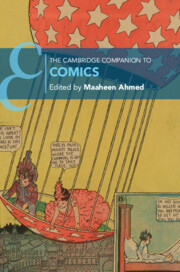Book contents
- The Cambridge Companion to Comics
- The Cambridge Companion to Comics
- Copyright page
- Contents
- Figures
- Contributors
- Acknowledgments
- Chronology
- Introduction
- Part I Forms
- Part II Readings
- Part III Uses
- Chapter 13 Comics and Their Archives
- Chapter 14 Readers and Fans
- Chapter 15 Comics in the Museum
- Chapter 16 Comics in Libraries
- Chapter 17 “Educationally Occupied”
- Further Reading
- Index
- Cambridge Companions To …
- References
Chapter 17 - “Educationally Occupied”
Learning with Comics
from Part III - Uses
Published online by Cambridge University Press: 17 August 2023
- The Cambridge Companion to Comics
- The Cambridge Companion to Comics
- Copyright page
- Contents
- Figures
- Contributors
- Acknowledgments
- Chronology
- Introduction
- Part I Forms
- Part II Readings
- Part III Uses
- Chapter 13 Comics and Their Archives
- Chapter 14 Readers and Fans
- Chapter 15 Comics in the Museum
- Chapter 16 Comics in Libraries
- Chapter 17 “Educationally Occupied”
- Further Reading
- Index
- Cambridge Companions To …
- References
Summary
This chapter explores scholarship on comics in education, examining the following themes: teaching with comics, teaching about comics, and teaching through creating and producing comics as a way of processing and communicating information. The chapter discusses each of these interrelated approaches in turn, examining the ways in which comics can be used in various learning contexts, demonstrating how educators, academics, and creators can work together to understand how comics might be used to encourage visual literacy and multimodal thinking for students.
- Type
- Chapter
- Information
- The Cambridge Companion to Comics , pp. 346 - 363Publisher: Cambridge University PressPrint publication year: 2023



